
13-2 The PCL Print Model
EN
Pattern
The design which is “painted” through the black (“1” bits) area of
the source image onto the destination image. For patterns, the Print
Model uses one of the printer’s internal predefined eight shading
patterns (see Figure 13-4) or one of the six cross-hatch patterns
(see Figure 13-5), or a user-defined pattern.
Notes
When printing a page, text and raster images are printed using the
current pattern. The default current pattern is 100% black. The print
model allows the current pattern to be changed to white, to one of
the six predefined cross-hatch patterns, to one of the eight shading
patterns, or to a user-defined pattern. Once the current pattern is
changed, it stays in effect until another is selected or the printer is
reset. A reset returns the current pattern to its default value (100%
black).
The current pattern does not always apply to rectangular area fill,
which uses patterns defined by the rectangular area fill pattern
commands. Refer to “Transparency Mode and Rectangular Area
Fills” at the end of this chapter for additional information.
Source Image
An image in which the black (“1” bits) are replaced by the specified
pattern. This is like a stencil through which the pattern is applied to
the destination image. The source image may be defined as a
rectangular fill area, a raster graphics image, or characters.
Destination Image
The image onto which the source image/pattern combination is
placed. The destination image is the result of any previous
operations.
Source Transparency Mode
The transparency or opaqueness of the source image’s white pixels
(the “0” bits) as they are applied to the destination image. Setting the
source transparency mode to 1 (opaque) applies the source image’s
white pixels to the destination image; with a setting of 0 (transparent),
these pixels have no effect on the destination.
Summary of Contents for LaserJet 4100
Page 1: ...Part I Click here to access Part II on hp com ...
Page 2: ......
Page 26: ...Contents 14 EN ...
Page 44: ...2 10 The Page EN ...
Page 54: ...3 10 The Print Environment EN ...
Page 70: ...4 16 PCL Job Control Commands EN ...
Page 80: ...5 10 Page Control Commands EN Figure 5 3 Changing Print Direction on a Page ...
Page 82: ...5 12 Page Control Commands EN Figure 5 4 Text Area Within the Page ...
Page 110: ...6 16 Cursor Positioning EN ...
Page 120: ...7 10 Fonts EN Figure 7 11 Bitmap Character Figure 7 12 Scalable Character ...
Page 122: ...7 12 Fonts EN ...
Page 152: ...8 30 PCL Font Selection EN ...
Page 166: ...9 14 Font Management EN ...
Page 182: ...10 16 User Defined Symbol Sets EN ...
Page 237: ...EN Character Descriptor Formats 11 55 Figure 11 5 Class 2 Character Data ...
Page 240: ...11 58 Soft Font Creation EN Figure 11 6 Portrait Character Example ...
Page 241: ...EN Character Descriptor Formats 11 59 Figure 11 7 Landscape Character Example ...
Page 270: ...13 4 The PCL Print Model EN Figure 13 3 Effect of Transparency Modes on Images ...
Page 276: ...13 10 The PCL Print Model EN Figure 13 4 Shading Patterns ...
Page 277: ...EN Pattern ID Area Fill ID Command 13 11 Figure 13 5 Cross Hatch Patterns ...
Page 290: ...13 24 The PCL Print Model EN ...
Page 297: ...EN Pattern ID Area Fill ID Command 14 7 Figure 14 1 Shading Patterns ...
Page 298: ...14 8 PCL Rectangular Area Fill Graphics EN Figure 14 2 Cross hatch Patterns ...
Page 341: ...EN Raster Graphics Example 15 33 Figure 15 11Example of Raster Graphic Image Data ...
Page 342: ...15 34 Raster Graphics EN ...
Page 370: ...16 28 Status Readback EN ...
















































